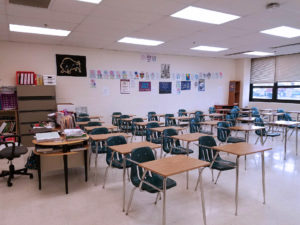
Classroom Acoustics – Educational Environment Design Not Just “Background Noise”
Research shows the good classroom acoustics are essential to support language acquisition and learning for all children, particularly younger children.
The VAK model of learning proposes that there are three different styles of learning in a classroom— visual (V), auditory (A) and kinesthetic/tactile (K).
- Visual learning is a teaching and learning style in which ideas, concepts, data and other information are associated with images.
- Auditory learning is a learning style in which a person learns through listening. An auditory learner depends on hearing and speaking as a main way of learning. In instruction for auditory learners, teachers use techniques such as verbal direction, group discussions, verbal reinforcement, group activities, reading aloud and putting information into a rhythmic pattern such as a rap, poem or song.
- Kinesthetic/tactile learning is a learning style that occurs while carrying out a physical activity, such as dance, sports, physical manipulation or experiments.
Learning modality strengths can occur independently or in combination, they can change over time, and they become integrated with age. It is estimated that auditory learners make up about 30 percent of the population.
Research shows that good classroom acoustics are essential to support language acquisition and learning for all children, particularly younger children. For children who have hearing loss and those who use cochlear implants, there is no substitute for a good acoustic environment. Assistive technologies typically only amplify the teacher and do not amplify discussions among children or between the teacher and individual child. Children with disabilities not related to hearing, such as autism and learning disabilities, may be adversely affected by high ambient noise levels. Students that use a different language at home will also be able to listen more closely to fully understand the teacher and benefit from conversation among peers. Teachers report that a good acoustic environment assists in controlling the classroom, reducing the need to raise their voices and promotes more civil behavior among students. Thus, good acoustic and low background noise in a classroom benefits everyone.
The ICC A117.1-2017 Accessible and Usable Buildings and Facilities added technical criteria for enhanced classroom acoustics. The requirements set specific criteria for maximum classroom size considered, maximum reverberation time and background noise in classrooms.
SIZE
The standard size elementary classroom in the United States holds 25 to 30 students. Many states specify the minimum size at 700 square feet—assuming 20 children in a room. The recommended size for a self-contained classroom is 800 to 960 square feet for grade school; 700 to 840 square feet for secondary school. Some researchers recommend up to 54 square feet per child as optimum—1,620 square feet for a 30-child classroom. Classrooms that are used for activities such as band, orchestra, choir or gym are significantly larger. Some lecture rooms in colleges are large enough to accommodate several hundred students.
The technical criteria for classroom acoustics are limited to classrooms with a size under 20,000 cubic feet; assuming a 10-foot ceiling height, classrooms that are 2,000 square feet or less. While acoustics may be important to larger classrooms, the criteria in this section are intended to be applicable to standard size self-contained classrooms. The criteria also are not intended to apply to ancillary learning spaces or other spaces where students may be, such as corridors or cafeterias.
REVERBERATION TIME
Reverberation time is how quickly sound decays within a room. The volume of the space and the surfaces in the room will affect the reverberation time. Large spaces such as a gym have a longer reverberation time, thus the high volume and echo of the sounds in the space. Small rooms with soft surfaces such as a recording studio have minimal reverberation, thus sounding dry or dead. Hard surfaces can be an issue because sound bounces off the surfaces, causing a discrete echo.
Consistent with long-standing recommendations for good practice in educational settings, the ICC A117.1-2017 standard set specific criteria for maximum reverberation time (0.6 to 0.7 seconds) and background noise (35 dBA/55 dBC) for unoccupied classrooms (see Table C808.1). The intent of the 0.6 to 0.7 seconds reverberation time is to increase the sound level from the teacher throughout the room while maintaining clarity. Using an unoccupied classroom for the acoustic review will allow for this test to be implemented outside of classroom time. Once children are in the room, while they make noise their bodies also absorb sound so the performance of the empty classroom should be adequate for the checking of acoustic requirements.
To determine an acceptable reverberation time, there is the option of using a performance method or a prescriptive method.
The performance method allows for a classroom to be tested to determine the decay rates using a sound isolation test. This method has the advantage of being able to use the furnishings to help with the reverberation time in the room. For how to do a performance test, see ASTM E2235-04(2012), Standard Test Method for Determination of Decay Rates for Use in Sound Insulation Test Methods.
The prescriptive method calculates a noise reduction coefficient (NRC). The NRC is the arithmetic average of the absorption coefficients of a material or surface in the 250 Hz, 500 Hz, 1 kHz and 2 kHz octave bands. This measurement is a good indication of how the material reacts with speech sound energy. The range is zero to one, with one indicating the surface absorbs most of the sound energy and zero indicates the surface reflects most of the speech sound energy.
The NRC for each material is multiplied by the square footage of that material. All surfaces are added together. The calculation must include all four walls of the room, including any windows or doors. Sound absorption materials may be added to the walls, floor or ceiling. The area of these materials will be subtracted from the surface they are on—for example, if the wall is 10 feet long by 10 feet high, and two 2-foot by 10-foot panels are added to the wall, the calculation would be for 60 square feet of uncovered wall and 40 square feet of panels.
Both tests use a fully furnished unoccupied classroom. The pictures below are an example of a kindergarten classroom and a high school classroom.


BACKGROUND NOISE
The technical criteria looks at ambient noise and sound sources inside and outside of the classroom.
*When designing classrooms, types of ambient noises from both outside and inside should be considered.
- Outside environment: noise from traffic, aircraft and industrial sources.
- Schoolyard and maintenance noise: playground or outside sports field noise, waxing
floors, set-up for assemblies or after school meetings, mowing the grass, and snow
removal. - Inside noise from adjacent spaces: classrooms next door, corridors, restrooms,
mechanical rooms, etc.
There are different ways to mitigate these issues. Some outdoor environment sources can be addressed by careful placement of the classrooms on the site (e.g., opposite side of the building from the busy road) or by the choice of the exterior materials for walls and roofs. Schoolyard and maintenance noise can be mitigated by site placement of the playgrounds or sports fields in relation to the classrooms, and/or by scheduling of playground usage, sports events or some maintenance activities. Sound levels between classrooms and common areas may be mitigated by the choice of partition wall systems, or even something as simple as not placing classroom doors immediately across the hall from one another. Heating and cooling systems may transmit noise through materials by vibration. These sources of noise can be addressed by choice of the type of system; placement and isolation controls of mechanical equipment; design of walls, floors and ceilings; vent layout; plumbing fixture location and supply; and drain pipe insulation.
The ambient sound levels must be measured in both dBA (A-weighted decibels) and dBC (C-weighted decibels). These are two different criteria—this is not a range.
MEASURING SOUND
Sound energy travels in waves and is measured in amplitude and frequency. Amplitude measures the sound waves of the material that is displaced; the higher the amplitude, the louder the sound. Frequency is referred to as the speed of the vibration, or the number of waves per unit time. It is the property of sound that most determines pitch; the higher the frequency, the higher the pitch. The International System of Units (SI) unit of audio frequency is the hertz (Hz). The standard range of audible frequencies is approximately 20 Hz to 20,000 Hz, although the range of frequencies individuals hear is greatly influenced by environmental factors. Frequencies above 20,000 Hz can sometimes be sensed by young people.
Background noise is the average sound level measured in decibels, or dB. The human ear filters sound to a certain level and is less sensitive to low frequencies; this is approximated by weighting the measurement mathematically. The resulting weighted and averaged sound level is called A-weighted decibels or dBA and is an approximation of the human perception of sound level at normal listening levels. In most literature, the terms dB and dBA are used interchangeably. As sound levels increase, the human ear filter changes, and at higher levels the filter approximation is called C-weighted or dBC.
Most noise levels are measured in dBA, or sound pressure. A decibel dB(A) measures the intensity of sound or what a humans perceives as how loud a sound is. Decibels are measured using a logarithmic scale; this means a difference of 10 in decibels is equal to a difference of 100 in relative energy of two sounds. Similarly, a difference of approximately 3 decibels represents a doubling or halving of the energy. Humans can hear sounds between 0 and 140 decibels. Normal speaking voices are around 65 dBA; 0 dBA is the softest level that a person can hear. A constant and ongoing decibel level of 85 warrants consideration for ear protection. A jackhammer is about 125 dBA. Distance affects the intensity of sound; if you are far away, the power is greatly diminished. The dBA for the sounds listed are taken while standing near the origin of the sound.
When you listen, it’s amazing what you can learn. When you act on what you’ve learned, it’s amazing what you can change. —Audrey McLaughlin






